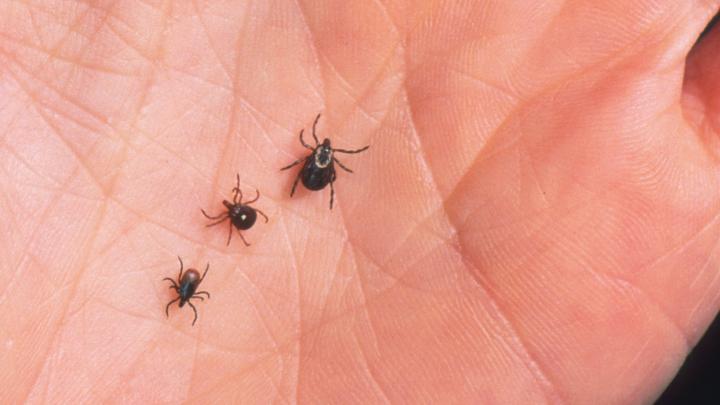Lately it seems all you hear about is TICKS! Ticks are everywhere and those little suckers are no fun! I grew up in the country and they were everywhere! More than once, I can remember my mom spotting a tick on me after I was out climbing trees or playing. I can recall going to the neighbor lady’s house with my mom and the two tag-teamed a tick on my scalp with the end of a hot match and some tweezers.
Finding a tick on your skin 30 years ago wasn’t quite as scary as it is now. No one worried too much about ticks — removing them was actually kind of a fun process (maybe I’m showing my Indiana roots with that comment!).
Anyway, now that I am the grownup in charge of keeping my kids safe from ticks, and I know that burning ticks off your child’s skin probably isn’t the best route for removal, it’s a whole new ball game. Safely removing ticks — some that are as small as a poppy seed — is something we need to know how to do. Ticks transmit some unpleasant and scary diseases, like Lyme disease and Rocky Mountain spotted fever. Take a look at these steps to prevent tick bites and make sure you know the symptoms to watch for in case you or your child has a tick bite.
Know your environment.
If you’re spending a lot of time outside, especially in areas that are known to have a lot of ticks, BE AWARE. There are areas where ticks live and thrive, such as tall grass and wooded areas. If you camp or hike, try to stay on the beaten path. Sit on a rock if you need to rest instead of sitting in the grass, and keep your kids out of areas with tall grass. If you have dogs, check them as well. No matter how well you check your kids, it doesn’t do any good if your pup brings ticks into your home.
Protect yourself.
Dress smart — if you’ll be in an area that has tick potential, dress in long-sleeved shirts and pants. Wear a hat and pull long hair up. It’s a good idea to wear boots too. Light-colored clothing is a great option – the light color provides contrast against the dark color of ticks so you can see them and brush them off before they attach themselves to your skin.
Use repellent.
Insect repellent on your clothes is a good place to start, especially if you use repellent that contains DEET. DEET deters ticks and is safe to use on children. Spray your hands first, then apply to your children’s skin. Make sure to check with your pediatrician if you have any questions.
Check yourself.
This is pretty obvious, but DO IT! Look at your children’s bodies thoroughly. Don’t forget to check places such as in and around the ears, the belly button, under the arms, behind the knees, and around the waist. If you have concerns about yourself, have someone else look at your back and head.
What to do if you find a tick:
You don’t need to suffocate it in Vaseline or try to smoke it out with a lit match or run the body under a stream of water. Good ole tweezers will work just fine. Gently grab the tick as close to the skin as you can. Pull the tick straight out with gentle pressure and never try to smash it. Disinfect the site after you remove the tick and closely monitor it, watching for skin infections.
Save the tick in a bag or empty pill bottle and add some damp toilet paper to keep the tick alive. Call the health office to submit your tick for testing.
Symptoms to watch for after a tick bite:
Hopefully you never need to use this information, but if a tick bites you or your child, there are some symptoms that are reg flags and an indication you should call the doctor.
Keep your eyes peeled for a round, red rash at the site of the tick bite and flu-like symptoms. These are signs of Lyme disease, an infection ticks spread. You or your child can catch it if a tick that carries the infection bites you. People may also feel tired and have a fever, sore muscles, or a headache. These symptoms can start from three days up to a month after a tick bite and some people have no symptoms initially.
Rocky Mountain spotted fever is a bacterial infection transmitted by ticks that can damage your heart, kidneys, and other organs. It’s commonly found in the southeastern part of the U.S. and in parts of Mexico, Central and South America, and Canada.
The early signs of Rocky Mountain spotted fever are high fever and a severe headache. A couple of days later, there is usually a rash around the wrists and ankles. Other symptoms include chills, nausea and vomiting, and restlessness and insomnia. See your doctor if you develop a rash or become ill after a tick bite.
Remember to play it safe especially this time of the year. It’s fun to let your kids run around outside, camp, and get fresh air — but it’s also necessary to take proper precautions. Ticks are awful! Be proactive and protect yourself. If you spot a tick or a bite, remember that the infectious diseases that ticks carry progress rapidly and can be life-threatening. Don’t hesitate to call your doctor if you suspect a tick-borne infection.
Photo credit: almanac.com
Like what you just read? Let’s connect on social media too:
Category: CampingTags: camping with children









